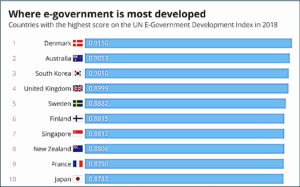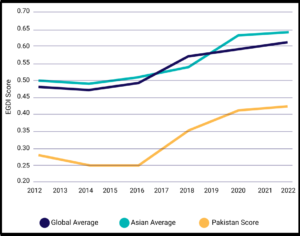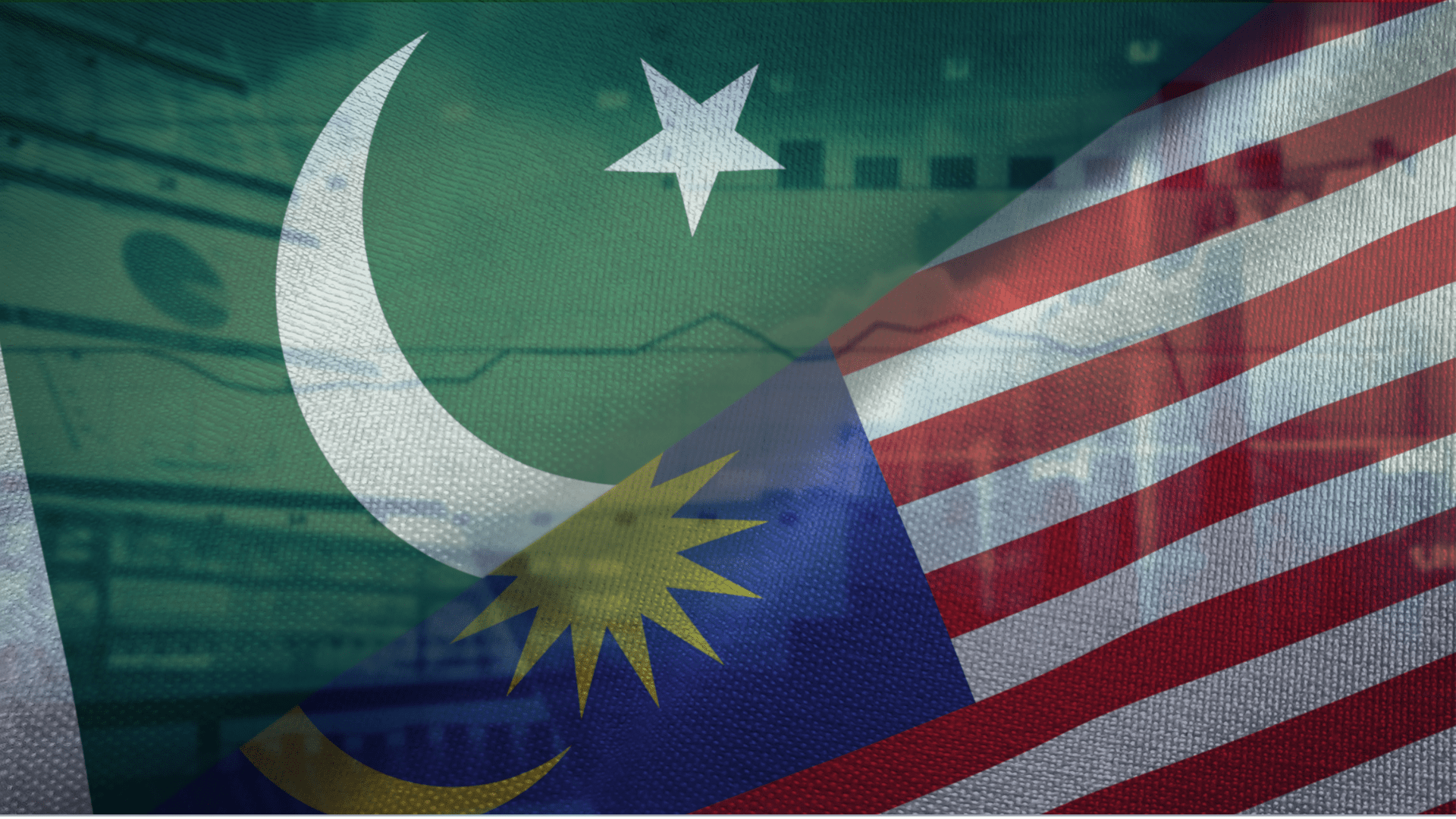This Insight focuses on Malaysia’s successful e-governance initiatives which can be seen as a model for developing nations like Pakistan to enhance public service delivery and institutional transparency.
E-governance, short for ‘electronic governance,’ primarily involves the sharing and exchanging of information between the government and its four primary stakeholders: citizens, businesses, employees, and other government institutions. It uses Information and Communication Technologies (ICT) to enhance government transparency, citizen services, and participation. The widespread adoption of ICT in governance is a positive indication of progress, instilling confidence about the future in its recipients. Countries such as Denmark, Australia, South Korea, the United Kingdom, Sweden, Finland, Singapore, New Zealand, France, and Japan are top e-governance performers, as reflected in Figure 1.

Figure 1: Countries with Highest Score on UN E-Government Development Index1 “Infographic: Where e-Government Is Most Developed.” 2018. Statista Daily Data. July 25, 2018. https://www.statista.com/chart/14851/where-e-government-is-most-developed.
A comparison of the E-Government Development Index (EGDI) scores from 2012 to 2022 for the global average, the Asian average and Pakistan is shown in Figure 2. The international and Asian averages steadily increased, showing continuous improvement in EGDI scores starting at around 0.48 in 2012 and reaching about 0.60 by 2022. Pakistan’s score began significantly lower at approximately 0.27 in 2012 but demonstrated an upward trend, reaching around 0.45 by 2022. Despite this progress, Pakistan’s score remains below the global and Asian averages, showing still lagging progress in e-government development. In this regard, Malaysia’s centralized e-governance platforms can offer Pakistan valuable direction and assistance in several ways.

Figure 2: Comparative Analysis of EGDI (2012-22)2Khan, Arsala, Hiba Fatima, and Arsala Khan and Hiba Fatima. 2022. “Slow and Unsteady: Pakistan’s Digital Government Challenge.” Tabadlab | Understanding Change (blog). November 28, 2022. https://tabadlab.com/slow-and-unsteady-pakistans-digital-government-challenge/.
As a developing nation, Malaysia adopted e-governance relatively later3Khan, Arsala, Hiba Fatima, and Arsala Khan and Hiba Fatima. 2022. “Slow and Unsteady: Pakistan’s Digital Government Challenge.” Tabadlab | Understanding Change (blog). November 28, 2022. https://tabadlab.com/slow-and-unsteady-pakistans-digital-government-challenge/. and launched its first project in 1990 to introduce ICT tools in government agencies. Despite the delayed start, Malaysia has not only caught up but also emerged as a success story, inspiring other nations with its determination and success. The 1992 Multimedia Super Corridor (MSC) E-Governance Flagship Application set Malaysia’s course towards extensive e-governance and service delivery4Alhabshi, Sharifah Mariam. n.d. “What We Have & Have-Not: E-Government In Malaysia..
Malaysia operates e-governance on three tiers of delivery, connecting the government and other sectors: government-to-government (G2G), government-to-citizen (G2C), and government-to-business (G2B)5Alhabshi, Sharifah Mariam. n.d. “What We Have & Have-Not: E-Government In Malaysia.. The primary goal is to streamline government activities with policy creation, coordination, enforcement, and implementation processes6Alhabshi, Sharifah Mariam. n.d. “What We Have & Have-Not: E-Government In Malaysia. Achieving this objective has enhanced government operations and created opportunities for convenient and accessible interactions between the government and citizen. Malaysia has introduced seven flagship applications, as listed in Figure 3.

Figure 3: Flagship Malaysian E-Governance Projects and Leading Agencies7Source: Created by the author.
The MY E.G. Services Berhad (MYEG) is a concessionaire for the Malaysia Electronic-Government MSC Flagship Application. This portal provides services such as bill payment, license renewal, and permit applications, enhancing security and convenience. Another notable initiative is the government’s Multi-Purpose Smart Card Project (MPSC) or MyKad, part of the MSC Malaysia programme. The MyKad identity card features a microchip capable of storing data and biometrics. While Pakistan’s smart cards also contain chips, this technology is still in the early stages of development and is intended for future8This data was obtained through an interview with an employee of NADRA (anonymous), designated as Superintendent (anonymous), aged 28, Islamabad Center. MyKad offers more advanced services than Pakistan’s Computerized National Identity Card (CNIC).
Furthermore, expanding e-services for citizens in Pakistan will involve initiatives such as online verification of national identity cards, passport renewal, vehicle verification, bill payments, and tax filing. These online services will save time and significantly reduce inconvenience compared to traditional paper-based processes, making them a valuable addition to the e-governance system9Institute of Business Administration, Karachi, Pakistan, Uzair Ahmed Siddiqui, and Waqas Mehmood. 2021. “E-Government in Pakistan – Implementation and Challenges.” International Journal of Education and Management Engineering 11 (6): 10–19. https://do i.org/10.5815/ijeme.2021.06.02.
The potential for Pakistan to adopt a similar digital identity system, such as the National Digital Identity Initiative Malaysia (NDID), can also make the efforts more compelling. This centralized system allows for quick and convenient online access to government and private sector services, eliminating the inconvenience and cost of traditional authentication methods like kiosks, branch offices, and counters. Despite the challenges posed by Pakistan’s diverse digital infrastructure, literacy levels, and geographical diversity, a customized approach could be considered to address these specific obstacles.
Additionally, Malaysia has demonstrated the effectiveness of its Open Data Initiatives (ODIs) in promoting transparency and innovation. These initiatives provide public access to government data and could be a model for Pakistan to enhance accountability. To fully realize the benefits of open data, Pakistan must not only address data privacy issues but also implement robust data protection mechanisms. By doing so, Pakistan can build on its current initiatives and establish a more robust and secure framework for the accessibility of public data, ensuring the safety and security of all stakeholders.
Malaysia’s e-services are available in multiple languages to accommodate its diverse population. Given Pakistan’s rich linguistic diversity, offering e-services in regional languages could be beneficial. This approach would promote inclusivity and improve access to these essential services. However, it would necessitate substantial investment in localization efforts and community engagement.
Although Pakistan has shown a commitment to improving its public services and transparency through an e-governance framework, potential areas of concern may arise as these initiatives progress. These include the need for more skilled ICT workers, efficient internet access, advanced government systems, and a formal e-governance model. Moreover, despite having a national digital strategy on paper, the provincial and local governments are working in silos10Aman, Shagufta. n.d. “Transforming Public Sector through E-Governance: A Case Study of Khyber Pakhtunkhwa.
Using Malaysia’s e-governance model, Pakistan can achieve digital sovereignty, socioeconomic development, and enhanced connectivity.
Pakistan needs to invest in infrastructure and capacity building and formulate clear regulations to realize its full potential for e-governance. Collaboration between national, provincial, and local governments is essential to establish a unified e-governance framework. This cooperation will enhance cyber security, combat corruption, and ensure equitable access to digital opportunities for all citizens. Expanding e-services will save time and reduce inconvenience compared to traditional processes, promoting equity and social justice.
Disclaimer: The views expressed in this article are those of the author and do not necessarily reflect the views or policies of The Global Dynamic.

